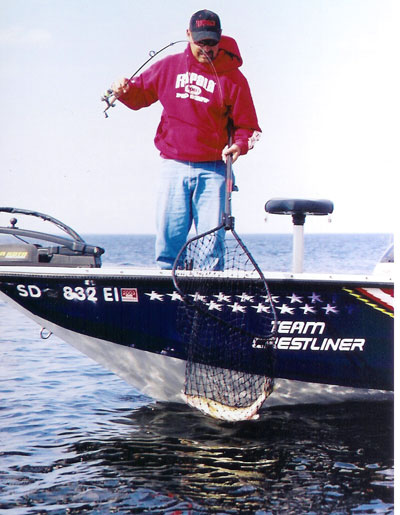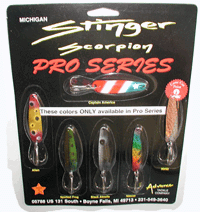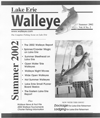Late summer and into early fall can make for tough fishing, especially if
you're a walleye angler. Old marble eyes can become difficult to find, and
even tougher to pattern. Most anglers have given up for the season, and many
of our top walleye lakes become almost desolate. It may seem a little eerie
to have so much water all to yourself but just because nobodyís around,
doesnít mean the fish arenít there. Itís just that where and when they do
what they do may have changed. Instead of giving up, you may be well served
to do what you do when and where the walleyes are doing it.
The late summer/early fall period is a time of consistent locations and patterns (good or bad), that set up and remain until late into August and
even September. On many natural lakes throughout the Midwest the action can
be pretty darn slow, especially if you stick with the usual tactics in the
usual places.
patterns (good or bad), that set up and remain until late into August and
even September. On many natural lakes throughout the Midwest the action can
be pretty darn slow, especially if you stick with the usual tactics in the
usual places.
The usual tactics includes live bait rigging and jigging, both of which
are main stays of any serious walleye angler. The usual places include deep
rocky bars and humps, or maybe underwater points, or even deeper weed lines
all of which can fall into the category of "classic" walleye structure.
Classic structure may start out as hot spots earlier in the summer but the
action may begin to wane as hordes of anglers take their toll on the
existing populations.
Another option available to all of those walleyes is to simply pull up
stakes and move and head for greener pastures. They may head for more of the
usual locations but on the other hand they may not. Instead of more of the
same they may actually leave all of the usual far behind and head for wide
open spaces, out in the middle of nowhere.
Rather than clinging tight to deep structure, late summer walleyes will
often suspend far off the bottom relating to nothing else but their next
meal. Suspended schools of perch, shiners, smelt, alewives and even immature
sunfish and crappies can draw walleyes along way from anything considered
"classic". If there is enough bait suspended there is going to be a sizable
following of walleyes, without a doubt. This phenomenon actually happens
more often than you may think, and may be your best bet for nailing dog day
walleyes.
Even if the usual spots are holding and producing fish there is a good
chance that a portion of the population will be suspended and may be the
secret to finding the super sized models. If youíre after a real hawg a
little time spent plying the great abyss may be the answer.
Determining if suspension is an option worth pursuing on your body of
water requires a little investigation. A couple of factors that help make it
all happen includes clearer water and a presence of suspended schools of
bait fish. Walleyes don't suspend because it feels good, they do it because
it's an excellent opportunity for filling their bellies. Water quality need
not be crystal clear but the option may be eliminated by the presence of
dark, dingy, or muddy water.
Finding suspended fish begins by taking a look around said deep structure
and heading into deeper and deeper water while keeping a close eye on the
depth finder. While it can be almost impossible to mark fish with your
average graph when on plane, the Ray Marine SL1250 combined with High
Definition Fish Imaging allows you to do just that.
The ability to mark fish while on plane can be a huge advantage as you
can cover a lot of water in a short amount of time. They won't show up as
classic arcs though, but instead show as spikes that are up off the bottom.
If you're marking spikes you better slow down and get a better look at what
might be down below. Clouds of bait and schools of bigger fish are what
you're looking for and if it starts to show up you can bet at least some of
what you're looking at is walleyes.
The next step is to get a bait in front of all those fish and see if
there any takers. The most efficient way to get the job done is to troll a
crank bait at the depth where you are marking the most fish. It sounds a
little complicated but it isn't all that difficult if you keep it in
perspective.
All you really have to do is get close and the fact is there will
probably be fish at many different levels. The thing to do is vary your
presentations and try and duplicate what works.
First timers should keep it as simple as possible and you can do so by
sticking with a couple of basic crank baits like the Shad Rap or Down Deep
Husky Jerk. They have different diving depths and actions and are about all
the variety you will need. From there you can tie one on and vary the amount
of line you have out to vary the running depth.
To achieve the maximum diving depth you'll have to let out a lot of line,
like a hundred feet or more. You can also add an inline weight about eight
feet or so in front of the lure to achieve even greater diving depths. By
varying the amount of line you have out, or the size of the inline weight
you're using, you can hit different depths. Working different depths is the
key and even if you're marking fish from top to bottom, there is usually a
narrow band holding the bulk of the biters.
Another thing to keep in mind is the spooking factor as suspended fish
exhibit all of their natural tendencies including being extremely boat shy.
Clip on planer boards are the way to go, as they can get your bait far and
away from the boat and in front of fish that haven't been harassed. They're
the way to go because they're inexpensive, easy to use, and easy to store.
If you get serious about trolling you may also want to add a couple of
rod holders as holding on to a rod, a board, and a deep diving crank bait
can get old fast. If you get really serious you might want to pick up a copy
of Precision Trolling as it will tell you exactly how deep a specific bait
will run with a specific amount of line out.





 patterns (good or bad), that set up and remain until late into August and
even September. On many natural lakes throughout the Midwest the action can
be pretty darn slow, especially if you stick with the usual tactics in the
usual places.
patterns (good or bad), that set up and remain until late into August and
even September. On many natural lakes throughout the Midwest the action can
be pretty darn slow, especially if you stick with the usual tactics in the
usual places.